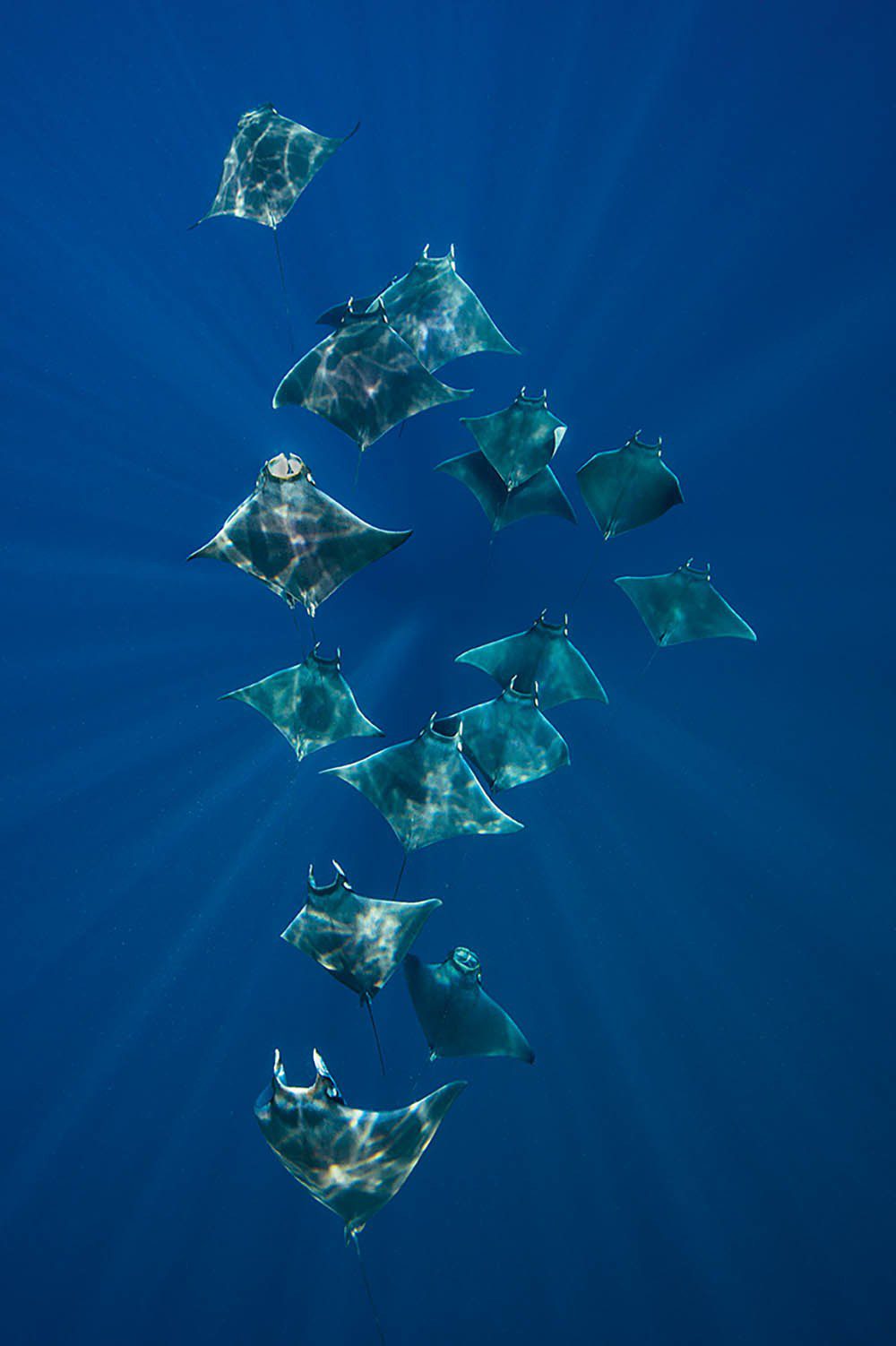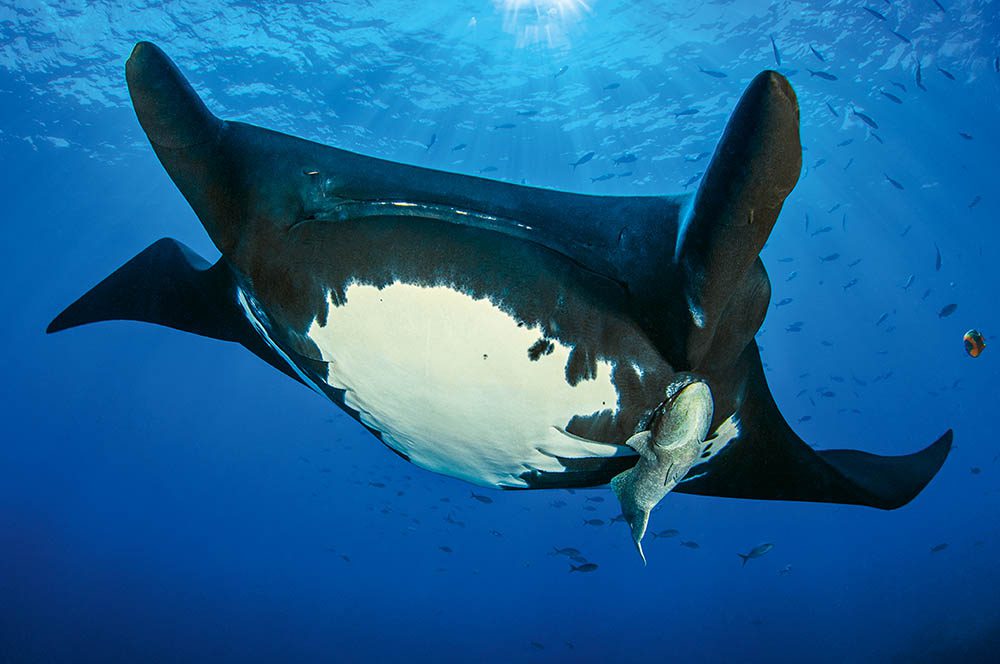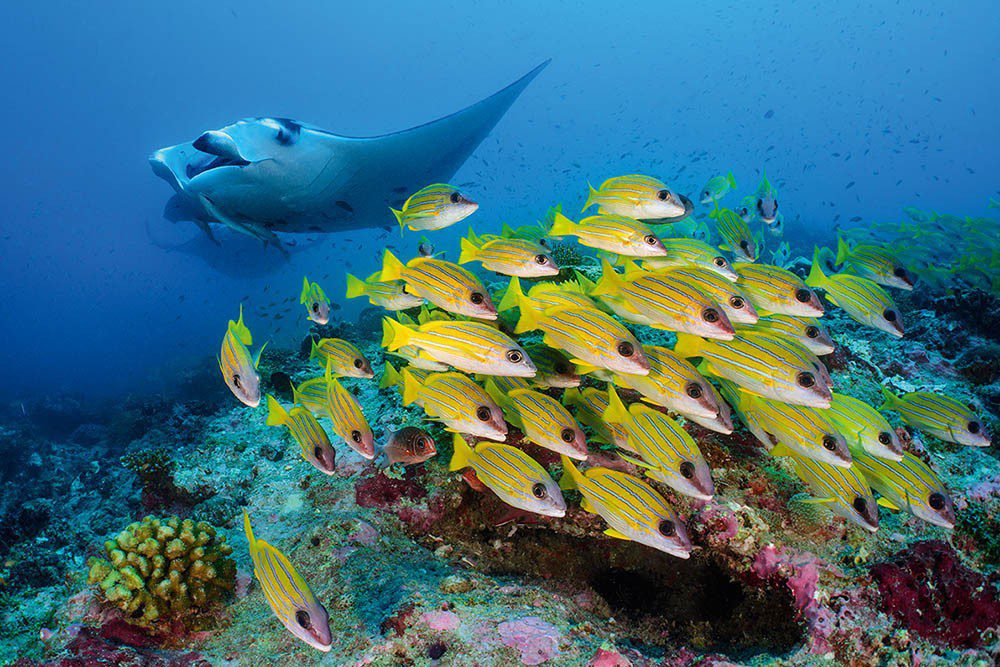PHOTO TECHNIQUE
How best to capture images of one of the ocean’s most emblematic animals? For this month’s Shark & Ray Special issue, ALEX MUSTARD zeroes in on manta and devil rays – and the importance of group discipline
‘With mantas I have often found that the fewer
photographers around, the better’

A group of mobulas feeding together. This scene was too large to illuminate with strobes, so I shot with available light only. Taken with a Nikon D4 and Nikon 14-24mm. Nauticam housing. 1/250th @ f/13, ISO 640.
SACRILEGE, SOME MIGHT SAY, but I have to admit that I often find whale sharks a bit boring. I always feel lucky to see one, especially because I have read that Jacques Cousteau swam with only three in his life, but to be honest the biggest fish in the sea doesn’t usually do much apart from steam on past like a submarine.
The biggest ray in the sea is something else entirely. Give me mantas every time.
Mantas and their cousins the devil rays soar through the big blue with balletic beats of their wings, yet have the power to leap clear of the water.
But my addiction stems from their brains, not their brawn. These are intelligent animals that have complex cleaning, feeding and mating behaviours, fascinating social interactions and are often as curious in looking at us as we are in them.
Mantas have unusually large brains for fish. In fact their brain-size to body-size ratio more closely matches that of large mammals.
This is something that won’t surprise any diver who has been fortunate to stare into the dark eye of a manta and felt that clear connection with another thinking being looking back.
This is also a group of rays that we are only just starting to learn about, even on the most basic level of how to classify them. It was only in 2009 that we realised that all mantas weren’t a single species, and that they were separated into reef and oceanic mantas. And now there is talk of a third species being resolved – the Caribbean reef manta.
Furthermore, recent genetic studies have shown that mantas are very closely related to other devils rays, and late last year their Latin name was changed from Manta to Mobula to reflect this.
Far more exciting than systematics is that scientists are really starting to build some proper insight into how they live their lives.
Much of this knowledge has just been published in a superb new book by Dr Guy Stevens of the Manta Trust and his co-authors (Book Review, July). It is a goldmine of information and insight for the underwater photographer, and has me booking up some manta trips ASAP.
CLEANING STATIONS are the most reliable place to encounter mantas at close enough range for high-quality photography. However, success here relies entirely on the whole group of divers playing by the rules laid out in the dive briefing. And more often than not there will be one person who doesn’t.
One of the most effective ways to improve our underwater pictures is to not simply take photos while you dive, but to dive to take photos.
This is most easily done when the diving is planned and organised by photographers, and is the reason why underwater photographers find that the quality of their images leaps forwards when they start buddying up and travelling with other photographers.
However, with mantas I have often found that the fewer photographers around, the better.
STARTER TIP
The key to high-quality manta photos is high-quality encounters. And the trick here is to follow expert advice from those who know the mantas best – your dive guides.
At cleaning stations it’s important not to block access to it, by hovering above the station itself or between it and open water. Guides are usually good at explaining exactly where to wait, but photographers aren’t always good at staying there!

Portrait of a curious oceanic manta. Taken with a Nikon D2X and Tokina 10-17mm. Subal housing. 2 x Subtronic strobes. 1/250th @ f/8, ISO 100.
Actually that’s a bit too simplistic. The real issue is just getting a group to stick to the plan, and a big group of photographers is especially likely to contain the moron who loses his or her head and spoils it for everyone!
The cause of the problem is rarely a desire to hog the opportunity and ruin it for everyone else. In my experience photographers get transfixed staring through their viewfinder or at their screen, and lose their peripheral vision.
Hypnotised by what their camera is seeing, they drift up towards the mantas, at best getting between everyone else and the action, and usually scaring the rays away from the cleaning station altogether.
MID-WATER TIP
The silhouette is one of the classic manta shots, because its characteristic outline is so distinctive. While the manta is approaching, turn off your strobes and dial in your camera’s exposure for the blue of the sky.
Don’t worry if the sun is over-exposing. Time your breathing so that your bubbles have passed up above the manta before it’s overhead, and shoot when it’s between you and the sun.
The fix isn’t actually being the only photographer, it is really making sure that all the group truly understand the benefits of following the rules, by staying off the cleaning station and low to the reef.
Talk about it enough pre-dive and the message will permeate even the thickest skulls, so that nobody ruins the action when it hots up.
I ran a workshop in the Maldives this year and the whole group was excellent. Every single manta dive we did was highly productive.

Even when mantas don’t come that close, we can still make strong images of them behind other subjects. Taken with a Nikon D5 and Nikon 28-70mm, Nauticam WACP. Subal housing. 2 x Seacam strobes. 1/125th @ f/13, ISO 500.
MANTAS ARE BIG. Oceanic mantas can reach 7m across, so require ultra-wide-angle lenses and big-scene wide-angle lighting technique. I prefer the flexibility of a zoom lens when shooting mantas (all three images here were taken with zooms) because you can never be sure just how close they will end up coming to you.
Also, when they do come really close fisheye lenses can be unflattering – giving them a big belly and tiny wings.
Typically when we shoot mantas during the day our main choice is between shooting with or without strobes.
Mantas are filter-feeders, so we often encounter them in murky plankton-rich water. When there are groups of mantas or devil rays feeding together, it’s usually best to turn off our strobes to capture these grand scenes. This works well, because strobes would simply light up backscatter and mantas aren’t colourful anyway, so we lose very little.
ADVANCED TIP
In Mexico, Hawaii and the Maldives you can dive with and photograph mantas and devil rays at night. Bright lights are shone down into the water to attract a rich soup of zooplankton, and this feast draws the rays.
Preset focus so that it isn’t hunting in the dark, and use high ISOs to capture the beams of artificial light.
Then shoot both with and without flash, to illuminate and silhouette the rays respectively.
Although I haven’t been recently, I believe that strobes are not actually allowed in Hanifaru Bay, the famous south-west monsoon manta-feeding site in the Maldives.
Cleaning stations tend to be deeper, so our photography benefits from strobes. Here we also tend to hunkered down on the reef, framing the mantas against the surface, so we need flash to fill in the detail of their silhouettes.
Mantas are eye-catching subjects, but we don’t necessarily have to use them as a foreground. Their instantly recognisable silhouettes make them the ultimate background in a reef scene.
While at cleaning stations we can compose mantas in both the foreground and background to give our images depth. We should always look out for other foregrounds, such as anemones with clownfish, soft corals or schools of fish behind which to frame a manta.
Finally still pictures never capture the grace of a manta’s flight, so consider attaching a GoPro, Paralenz or similar action camera to the top of your housing to get some video as you shoot your pictures on these dives.

